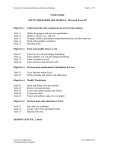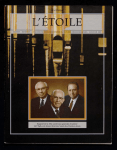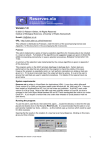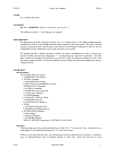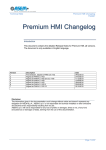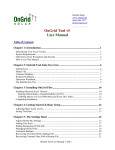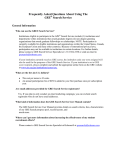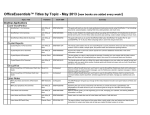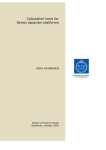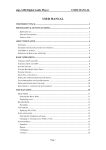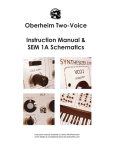Download Setting off
Transcript
Chap-01.qxd 28/8/04 11:56 Page 1 C H A P T E R 1 Setting off Chapter objectives This chapter will help you to: ■ ■ ■ ■ assess the importance businesses attach to quantitative methods make full use of this book apply arithmetical procedures use the technology: calculators and computer software Beginning a new programme of study is always something of a challenge. To help ease you into the study of quantitative methods this chapter begins with an outline of the importance of numbers in business life. Following that is an overview of this book and ways in which it can assist in your studies. The next section provides guidance on arithmetical procedures that feature in the techniques you will meet in later chapters. The chapter closes with advice on the use of calculators and software that can take the hard graft out of the analysis to allow you to concentrate on interpreting the results. 1.1 Quantitative methods, numbers and business If you are studying business or interested in any aspect of business you need to know about quantitative methods. Why? Because business is all about quantities: quantities of goods produced and services provided, quantities of inputs and costs, quantities of revenues and profit, and so on. How many times have you seen a news programme that does not mention numbers? How many times have you read a newspaper in which no numbers are quoted? Numbers are integral to our way of life, Chap-01.qxd 2 28/8/04 11:56 Page 2 Quantitative methods for business Chapter 1 our understanding of the world around us. This is especially so of the business world that, now and in the future, we relate to as customers, employees, suppliers. Consider how numbers played a part in the publisher’s decision to produce this book. They were interested in the size of the potential market, which meant looking at the number of students on business courses. They needed to set a price, which led them to consider the prices of rival texts on the one hand and their own production costs on the other. The production costs would depend in turn on the number of pages in the book and the number of copies to be produced. You may feel rather uncomfortable at the prospect of studying numerical subjects. Perhaps memories of Maths at school have left a legacy that leads you to associate analysing numbers with mental numbness. If this is what happened to you, it is best to try to put it behind you. For one thing the focus you will find here is on applications and interpretation rather than proof and derivation. It may help to bear in mind that employers consistently identify numerical and problem-solving skills as highly desirable qualities in potential employees, so try to think of your quantitative studies as building a valuable career asset. For example, in graduate recruitment literature the Exxon Mobil Corporation state that ‘Numerical and analytical skills are essential for all vacancies’ (Hobsons, 2002, p. 320). If you do approach the study of quantitative methods with trepidation you may be tempted to think that this is a subject that really doesn’t matter because it is of no use to businesses. It might be comforting to think that the subject is irrelevant because this would excuse not bothering with it. In fact the subjects that you will meet in this book have in many cases been forged in and grown up with the business world. The origins of many of the techniques described in this book are embedded in the history of business sectors as diverse as brewing and insurance. This is not an opinion held only by people who teach it; a number of researchers have tried to establish the use that companies make of quantitative methods. Usually these studies are aimed at finding how widespread is the use of a particular type of technique, but occasionally researchers canvass the application of the spectrum of techniques that comprise quantitative methods. One comprehensive study was a survey of American companies undertaken in the 1980s (Kathawala, 1988). Kathawala surveyed US companies that were in the ‘Fortune 500’. Fortune is an American business magazine that periodically compiles lists of the most prominent companies in the USA. He sent questionnaires to firms in the manufacturing and service sectors, as well as a Chap-01.qxd 28/8/04 Chapter 1 11:56 Page 3 Setting off 3 random sample of small companies. Respondents were asked about the extent to which they used a variety of quantitative techniques. Thirteen of these techniques feature in this book. Approximately half or more of the respondents’ organizations put the majority of these to moderate, extensive or frequent use. Some were very widely used; in the case of forecasting only 6% of respondents reported little or no use. Kathawala found that in general large companies were more likely to use quantitative methods than small companies. He also found that some techniques were widely used in certain sectors; for example, all respondents from the retailing sector reported that they used stock control methods, whereas all the life insurance companies said they used computer simulation. One interesting aspect of Kathawala’s study was the reasons companies gave for not using quantitative techniques. Foremost among these were that managers lacked knowledge of them. In other words, many respondents who reported that particular techniques were not used said that it was because they had no training in them, not that the techniques were considered to be of no value. The comprehensive nature of the study makes Kathawala’s work interesting, but it is now some years old. However, in the years since it was published the quality and availability of computer software that performs quantitative analysis has vastly improved, suggesting that the use to which businesses put quantitative methods has increased rather than decreased. 1.2 Using this book This first chapter constitutes a prologue or launch pad for your studies. It is designed to help you start with an idea of the relevance of the subject, an outline of the structure and approach used in this book, and what might be termed a refresher course in the basic ‘tools of the trade’. Chapters 2 and 3 cover simple deterministic models that can help to represent and understand business operations. The term deterministic is used because the numbers used in such models are fixed or predetermined. Chapters 4 to 9 introduce descriptive techniques, methods that will enable you to arrange or analyse sets of figures in ways that help to describe the situation being studied. These are important because typically figures do vary and the way in which they vary is of interest. Chapters 10 to 14 deal with techniques and models that allow the risk inherent in business situations to be reflected in the analysis of Chap-01.qxd 4 28/8/04 11:56 Page 4 Quantitative methods for business Chapter 1 them. Chapters 15 to 17 are about inferential techniques, methods that enable you to make inferences or draw conclusions about an issue in general based on the study of a comparatively modest amount of data. The final chapter is designed to help you tackle numerical aspects of the sort of project or dissertation that you will probably be asked to write towards the end of your course. The book will introduce you to a variety of analytical techniques drawn from the fields of Business Mathematics, Operational Research and Statistics that together constitute a ‘tool-kit’ of methods that can be used to investigate situations and help solve problems. Like any other tool-kit, the key to using it properly is to know not only what each tool does, but also how and when to use it. The book will help you develop this ability by illustrating the application of the methods described using business contexts. To help you appreciate the wider relevance of the methods you will meet, there are sections identified as Road tests. These are outlines of applications of the techniques in the business world, drawn from the publications of those who undertook the work. The original sources are listed in the References at the back of the book. These sections are intended to reassure you that these techniques are important and so your study of them is not in vain. Some of the sources used were published some time ago and describe pioneering work with the techniques concerned; in such cases the use of the techniques has become so commonplace that it does not merit publication. In other cases commercial confidentiality means that illustrative rather than actual data has had to be used. These published accounts of the application of quantitative methods are really only the tip of a sizeable iceberg; the everyday use of the techniques you will be studying is vast, but unseen. Techniques will be explained and demonstrated using worked examples. Calculations will be outlined in words before symbols are used to represent the process. Techniques will be explained and demonstrated using worked examples. Solutions to these worked examples will be precise or accurate to three decimal places, unless otherwise stated. Being able to apply a technique, to produce the correct result from a calculation, is important, especially if you find ‘learning by doing’ useful, but it is by no means all that is involved. It is even more important to be able to interpret the results that the technique has enabled you to produce and to communicate the meaning of those results. In your future career you may be asked to apply techniques of analysis but you are much more likely to need to be able to explain results, perhaps to judge whether appropriate techniques have been used to produce Chap-01.qxd 28/8/04 11:56 Page 5 Chapter 1 Setting off 5 them. The book therefore provides you with not only a description of each technique and an illustration of its use, but also a discussion of the types of results you could get, and what each of them would mean. At the end of each chapter there are review questions that you can use to confirm your understanding of the methods and ideas featured in the chapter. Questions that relate to particularly important aspects of the chapter content are flagged as Key questions. You can find fully worked solutions to these key questions and answers to the other review questions at the back of the book alongside which you will find references to examples in the chapter. In each case the example is very similar to the question, so that if you do not obtain the correct answer you can refer to the example for guidance. All numerical answers are precise or accurate to at least three decimal places unless stated otherwise. 1.3 Key arithmetical procedures Certain numerical operations feature in many of the techniques that you will meet later on, so this section is designed to help remind you of them and introduce you to some you may not have met. 1.3.1 Addition and subtraction Addition, represented by the plus sign ‘’, is the process of putting two or more numbers together to make a sum or total. As long as the numbers being added together are positive, i.e. more than zero, the resulting total grows as more numbers are added. Example 1.1 A sales manager has to drive to a regional office from the company headquarters. The route involves driving 7 miles to a motorway junction, 15 miles along the motorway, 4 miles along a major road, and finally 3 miles across a city. What is the total length of the journey? You can get the answer by adding together the distances for the four parts of the journey. Total distance 7 15 4 3 29 miles Chap-01.qxd 28/8/04 11:56 Page 6 6 Quantitative methods for business Chapter 1 Although you are probably already familiar with addition, you may not have encountered the symbol called ‘sigma’, which is used to represent it. Sigma is the letter capital S from the Greek alphabet, written as ‘’. It is the letter s because s is the first letter of the word ‘sum’. It is a Greek letter because at the time that many quantitative techniques were developed, the ‘classical’ languages of the ancient world were taught in schools and universities. The Greek language, with its specific alphabet, provided the pioneers of these techniques with a source of distinctive symbols. Although it may seem that the use of letters and symbols by mathematicians is a conspiracy to intimidate the rest of the world, actually they distil the essence of an operation from what would otherwise be a mass of words. The symbol (sigma) simply stands for ‘the sum of’. It is a form of shorthand that is used for convenience. Similarly letters are often used in numerical subjects to represent quantities, sometimes to abbreviate a procedure involving specific numbers and sometimes to represent a procedure in general. For instance, ∑x means ‘the sum of a series of numbers, each of which are represented by the letter x ’. Sometimes it is important to identify precisely which of a set of numbers are to be added together. To show this, the letter ‘i’ is used to count the numbers, for example, 3 ∑ xi means ‘the sum of the first to the third numbers’. i1 The expression ‘i 1’ below the sigma tells us to start the addition with the first number and the ‘3’ above the sigma sign tells us to finish the addition with the third. Example 1.2 In the situation described in Example 1.1, we could show that the total distance travelled (which we could represent by ‘D’) is the sum of the distance for the four parts of the journey (represented by d1, d2 etc.) using the expression: 4 D ∑ di d1 d2 d 3 d 4 7 15 4 3 29 i 1 Chap-01.qxd 28/8/04 11:56 Page 7 Chapter 1 Setting off 7 If we want to indicate that all of a set of numbers should be added together and we don’t know exactly how many there are, we can use the letter ‘n’ to represent the last number in the set, so n ∑ xi means ‘the sum of the first to the last of the numbers’. i1 At first these types of symbol may appear strange to you, but it is worth learning to recognize and use them as they can become very useful shorthand forms which will save you space and time in future work. Subtraction, represented by the minus sign ‘’, is the process of subtracting or ‘taking away’ one or more numbers from another. As long as the numbers being subtracted are positive, i.e. more than zero, the result reduces as more numbers are subtracted. Example 1.3 An on-line music business has a stock of 49 copies of a CD at the beginning of February. In the first week of the month it received orders for 11 copies, in the second week orders for 6 copies, in the third week orders for 9 copies and in the final week orders for 13 copies. How many copies will be left in stock at the end of the month? You can get the answer by subtracting the orders from the initial stock: Stock at the end of the month 49 11 6 9 13 10 An alternative approach to this operation is to add the orders first and then subtract the total orders from the initial stock. This would be written as: Stock at the end of the month 49 (11 6 9 13) 49 39 10 The round brackets dictate that the operations shown within them have to be carried out first. They are used to indicate priority. You may well find addition and subtraction fairly easy, but there are cases where they are not so straightforward; first, when negative numbers are involved, and second when the operation involves numbers measured in awkward units, e.g. minutes and hours. Addition and subtraction may give you some difficulty if negative numbers are involved. If a negative number is added to a total, it reduces the total. Chap-01.qxd 28/8/04 11:56 Page 8 8 Quantitative methods for business Chapter 1 Example 1.4 A customer purchases four items in a supermarket: a pizza costing £2.50, milk costing £1.50, and two deodorants costing £3 each. The deodorants are on a ‘two-for-one’ special offer. What is the total bill the customer should expect? Because the till adjusts for the special offer after the second deodorant has been scanned, the answer might be written as: Total bill £2.50 £1.50 £3 £3 (£3) £7 Here round brackets have been used, both to highlight the fact that there is a negative number in the sequence and to indicate that it must be dealt with first. This means deciding how to tackle the apparently contradictory ‘ ’ sequence of symbols. In fact the minus sign overrides the plus sign, so adding a negative number is the same as subtracting a number. The arithmetical expression used to find the total amount in Example 1.4 has exactly the same result as the following expression, which combines addition and subtraction: Total bill £2.50 £1.50 £3 £3 £3 £7 But what do you do if you have to subtract a negative number? In fact subtracting a negative number produces the same result as adding a positive number. Example 1.5 The till operator notices that the deodorants the customer has selected are not those on special offer, the offer applies to a similar product. How will this change the total bill? The special offer reduction of £3 has to be taken from the previous total, so now: Total bill £7 (£3) £10 You get exactly the same result if you simply add the amount concerned, £3. You may find it helpful to think of the two minus signs ‘cancelling each other out’ to leave you with an addition. This is rather like the interpretation of double negatives in the English language where, for instance the sentence ‘I won’t do it for nothing’ means ‘I want something’. Alternatively it may help to think that taking away a negative is always positive. Chap-01.qxd 28/8/04 11:56 Page 9 Chapter 1 Setting off 9 Addition and subtraction involving time is something many people find difficult because time is measured in hours made up of sixty minutes, and minutes made up of sixty seconds, rather than nice neat numerical parcels of ten. The use of the 24-hour clock on top of all this is simply too much for many people. Example 1.6 A parcel delivery driver has to deliver packages to four customers. From the depot it takes 15 minutes to reach the first, a further 40 minutes to reach the second, a further 12 minutes to reach the third, and a further 27 minutes to reach the fourth. It takes 1 hour 10 minutes to reach the depot from the last customer. What is the total driving time? To get the answer we can express all the times mentioned, including the duration of the last stage, in minutes. Total journey time 15 40 12 27 70 164 It may be more useful to express the answer in hours and minutes. To do this we need to find how many lots of sixty minutes there are in 164 minutes. The answer is two, so the total journey time is two hours (120 of the total number of minutes) and 44 minutes (the number of minutes left over if 120 is subtracted from 164). Example 1.7 If the driver in Example 1.6 starts at 11am, at what time will she arrive back at the depot (assuming the time for delivering packages from the van is negligible), and what time is this on the 24-hour clock? To get the answer, work in hours first, then minutes: Arrival time 11 2 hours 1pm 44 minutes 1.44 pm To express this using the 24-hour clock, add 12 to the number of hours, because the arrival time is after midday: Arrival time 1.44 12 13.44 But if the driver started the route at 11.45am what time would she get back to the depot? This is a little more complicated because the Chap-01.qxd 28/8/04 11:56 Page 10 10 Quantitative methods for business Chapter 1 departure time and total journey time are measured in both hours and minutes. To find the answer we can start by adding the hours: 11 2 13 Then add the minutes together: 45 44 89 Since this amount of minutes is more than 60, i.e. longer than an hour, we have to express it in hours and minutes, and add the result to the sum of the hours: 89 minutes 1 hour and 29 minutes 13 1 14 hours 29 minutes 14.29, or 2.29pm. 1.3.2 Multiplication and division Multiplication, or ‘times-ing’, represented either by the asterisk ‘*’ or the ‘times’ sign ‘’, is the process of multiplying two or more numbers together. The result is called the product. If a number is multiplied by another number that is greater than one, the product will be greater than the original number. Example 1.8 A domestic heating supplier is replacing gas boilers in a housing complex. A new boiler can supply up to 15 litres of hot water per minute. According to the original specifications an old boiler could supply up to 14 quarts of hot water per minute. There are 1.137 litres in a quart. Will a new boiler supply hot water at a greater rate than an old one? We need to convert the quarts given for an old boiler into litres by multiplying the number of quarts by the conversion rate: Litres per minute 14 * 1.137 15.918 We can conclude that a new boiler will not supply hot water at a greater rate than an old one. In this case the number of litres is greater than the number of quarts, the product represents a numerical increase. But if you multiply a number by another number that is less than one, you will get a product that is lower than your first number. Chap-01.qxd 28/8/04 11:56 Page 11 Chapter 1 Setting off 11 Example 1.9 An exporter needs to send a package weighing 20 lb abroad. The airfreight company they use require the weight to be given in kilograms. If one pound is 0.4536 kilograms, what is the weight of the package in kilograms? Find the answer by multiplying the number of pounds by the conversion rate: Weight in kilograms 20 * 0.4536 9.072 But what if the multiplication involves negative numbers? If you have to multiply a positive number by a negative number, the product will be negative. However if you multiply two negative numbers together, the product will be positive: 4 * (2) 8 but (4) * (2) 8 The two negatives ‘cancel each other out’ when they are multiplied together. If more than two negative figures are multiplied together, whenever the number of figures is odd the result will be negative, whereas when the number of figures is even the result will be positive: (3) * (2) * (2) 12 but (3) * (2) * (2) * (2) 24 Division, or finding how many times one amount ‘goes into’ another, is the process of dividing one number by another. It is represented either by the forward slash ‘/’ or the sign ‘’. If you divide a number by another number that is greater than one, the result will be smaller than the original number. Example 1.10 A small design partnership makes a profit of £94,200. If the profit is shared equally between the six partners in the business, how much should each partner receive? Find the answer by dividing the profit by the number of partners. Profit share £94,200/6 £15,700 If you divide a number by another number that is less than one, the result will be larger than the original number. Chap-01.qxd 28/8/04 12 11:56 Page 12 Quantitative methods for business Chapter 1 Example 1.11 A businessman from abroad travels 341 miles in the UK. On his return he must enter the number of kilometres he has travelled on his expense claim. A kilometre is 0.62 of a mile (to 2 decimal places), so how many kilometres should he record? To get this you have to divide 341 by 0.62: Kilometres travelled 341/0.62 550 1.3.3 Squares, powers and roots Taking the square of a number is the process of multiplying a number by itself. The process is represented by the number with a superscript showing the number two, for example the square of three, or three squared would be written 32, which tells us to multiply three by three. If the number you want to square is more than one, the result will be larger than the number itself, for instance the square of three is nine. However, if the number you want to square is less than one, the result will be smaller than the number itself, for example the square of a half is a quarter. Example 1.12 A company changes its logo and must order a new square brass plate measuring 65 cm long by 65 cm wide for the main office. The cost of the plate will be based on the area of the plate. There are two possible suppliers: Boldazbrass, who need the area in square centimetres, and Striking Plates, who need the area in square metres. What figures should be given to the suppliers? To find an area multiply the length by the width. Here because the plate is square, that is, the length and width are the same, we can simply square 65 to get the figure for the first supplier: Plate area for Boldazbrass 652 4225 square centimetres To get a figure in square metres for the second supplier we have to divide 65 by 100 so that the dimensions are expressed in metres before we square them: Plate area for Striking Plates 0.652 0.4225 square metres Chap-01.qxd 28/8/04 Chapter 1 11:56 Page 13 Setting off 13 Squaring a positive number will always give you a positive result. But because multiplying one negative number by another always gives you a positive product, squaring a negative number will always give you a positive result as well. 32 9 and (3)2 9 So, The fact that we always get a positive result when we square a negative number is worth remembering because it plays a vital role in several techniques you will meet. The number 2 in 32 is known as the power to which 3 is raised, which means the number of threes that have to be multiplied together. Three to the power three indicates that three should be cubed, that is three threes should be multiplied together: 33 3 * 3 * 3 27 Multiplying with numbers expressed in powers involves adding the powers, so: 32 * 33 35 Three to the power five (3 * 3 * 3 * 3 * 3) is 243 so this is simply another way of saying nine times twenty-seven. At first sight it might seem odd to be adding something when the sign ‘*’ says multiply but in adding the powers (two plus two to give four) we are simply counting the number of threes that would have to be multiplied together to get the answer. Before electronic calculators became widely available powers were used to carry out multiplication because adding powers was easier. This is what logarithms were about; converting numbers into the powers of ten meant that any multiplication, no matter how complex, could be undertaken using only addition. Whilst our access to calculators today means that we have no such need for logarithms for arithmetical convenience, you will probably find powers of ten used when very large numbers are shown in calculator displays and computer software. Example 1.13 An economist wants to find how much it would cost to give every resident of the UK half a million pounds, assuming the UK population is 56 million. If you multiply fifty-six million by half a million on your calculator (56,000,000 * 500,000) it will probably show something like: 2.813 or 2.8*10 13 or 2.8E13 Chap-01.qxd 28/8/04 14 11:56 Page 14 Quantitative methods for business Chapter 1 The calculator produces the answer 28000000000000 but has insufficient space to fit in all the zeroes, so it uses powers of ten to represent them and expresses the answer as 2.8 times ten to the power thirteen. The power, thirteen, is the number of times you would have to multiply 2.8 by ten to get 28,000,000,000,000. The letter E in the third version of the expression stands for exponent, another word for power. Large numbers like the result in Example 1.13 are quite common in the business world, for example the Gross Domestic Product (GDP) of a country or the earnings of a large corporation. Such numbers are sometimes expressed in billions, but be careful because in US terms a billion is one thousand million whereas the convention in the UK is that a billion is one million squared, i.e. one million million. The answer in Example 1.13 would therefore be 28,000 ‘US billion’ or 28 ‘UK billion’. When you use published figures that are quoted in billions it is worth checking which definition has been used. You will probably find that in business and economic figures the US usage prevails. You will also come across negative powers or exponents in calculator and computer work. To understand negative powers it helps if you are aware that dividing with numbers involving powers means subtracting the powers, for instance: 33 32 31 This is another way of saying three cubed (27) divided by three squared (9) is three; the result is three to the power one since a number raised to the power one is simply the number itself. If we use the same approach to divide three cubed by three cubed, we get three to the power zero: 33 33 30 Three cubed is twenty-seven, so this is the same as dividing twentyseven by twenty-seven, which gives us one. So three to the power zero is one; in fact any number to the power zero is one. If we divide three squared by three cubed we get a negative power: 32 33 31 Here we are dividing nine by twenty-seven, which gives us one-third. A number raised to the power minus one is one over that number, which is known as the reciprocal of the number. A number raised to the power minus two is one over the square of the number: 32 34 32 Chap-01.qxd 28/8/04 Chapter 1 11:56 Page 15 Setting off 15 This is the same as saying nine divided by eighty-one is one-ninth, or one over the square of three. In the same way as positive powers of ten are used in calculator displays and computer software to represent very large numbers, negative powers of ten are used to represent very small numbers. Example 1.14 Half a kilogram of a hazardous chemical is deposited by accident in a tank holding 800 million litres of water. If the chemical disperses throughout the contents of the tank, how much will there be per litre of water? If you divide one-half by 800 million on your calculator (0.5 800000000) you will probably see: 6.2510 or 6.25*10 10 or 6.25E10 The answer is 0.000000000625 kilograms per litre but there is not enough room for all the zeroes, so the calculator uses negative powers of ten and the answer is shown as 6.25 divided by ten to the power ten, in other words 6.25 divided by ten ten times. Taking the square root of a number, represented by the radical or ‘tick’ sign, √, means finding what has to be squared to produce the number. The square root of nine, shown as √9, is three because the number three multiplied by itself gives you nine. You should bear in mind that the result of √9 could be 3, since the square of 3 is also nine. Having said that, in most business contexts it is the positive root that is of interest. Example 1.15 A mobile phone retailer has been sent a pack of merchandising material that has to be assembled in the shop window for the launch of a new ‘Square Deal’ product. At the heart of the display is a fluorescent mosaic in the shape of a square that must be made up of centimetre square stickers. If the pack contains 234 stickers, what are the maximum dimensions of the mosaic square, assuming that the stickers cannot be cut? You can determine the answer by taking the square root of 234: Length/width √ 234 15.297 The maximum dimensions would be 15 centimetres long by 15 centimetres wide. Although √234 is also 15.297 the concept of negative dimensions makes no sense here. Chap-01.qxd 28/8/04 16 11:56 Page 16 Quantitative methods for business Chapter 1 An alternative form of representing the square root of a number is to show the number to the power of a half, so: √ 3 31 2 If you square the square root of a number you get the number itself, so: √3 * √3 3 We get the same result adding powers: 3 1 2 * 31 2 31 3 1.3.4 Fractions, proportions and percentages Fractions, proportions and percentages sound different, but they are only different ways of doing the same thing: expressing a part of something in relation to its whole. If, for example, a company employs 100 people of whom 25 are women, this could be expressed as: or or women make up one-quarter of the labour force women make up 0.25 of the labour force women make up 25% of the labour force. One-quarter is a fraction, 0.25 is a proportion and 25% is a percentage. They are different ways of saying the same thing because there are four quarters in one, four lots of 0.25 in one and four lots of 25% in 100%. You should bear in mind that each of them is a number less than one, including the percentage, which doesn’t look as if it is less than one. It is easier to use percentages if you understand that the literal meaning of ‘percent’ is per hundred. (Centum meant one hundred in Latin, cent is French for a hundred, cento is Italian for a hundred, and a century is a hundred years.) This will help especially when you have to perform arithmetical operations using percentages. Example 1.16 A bookshop gets £20 for every copy of a particular book sold, 70% of which is paid to the publisher. The publisher pays 10% of the 70% they get to the writer of the book. If the bookshop sells 270 copies, how much will the writer get? The bookshop gets 270 * £20 £5400 Chap-01.qxd 28/8/04 Chapter 1 11:56 Page 17 Setting off 17 To work out how much of this the publisher will get you may be tempted to multiply £5400 by 70 and get £378,000. Although the publisher would be delighted by your result it far exceeds the amount the bookshop received for the books! The result is distorted because we have multiplied by 70 not 70%. To do it properly we need to multiply by 0.7, the proportion form of 70%, or by 70/100, the fraction form of 70%. 5400 * 0.7 £3780 5400 * 70/100 To find the amount the writer will get we need to take 10% or one-tenth of this, £378. We could represent the whole procedure as: 270 * 20 * 0.7 * 0.1 £378 Proportions are the easiest form of numbers less than one to deal with because they are ‘calculator friendly’, but you may occasionally come across arithmetical operations involving fractions. Addition and subtraction with fractions is straightforward if the figures below the line, the denominators, are the same: 2 3 1 5 5 5 But if the denominators are different we need to make them compatible. The easiest way of doing this is to multiply them together to find a compatible or common denominator, a unit that can be used for both numbers. Example 1.17 A third of visitors to an Internet site use the Alpha service provider and a quarter use Omega. What fraction of visitors uses Alpha or Omega? To find this we need to add a quarter to a third, 1 1 3 4 But these are incompatible; thirds are not the same as quarters. If we multiply three by four we get twelve. Since both a third and a quarter can be expressed in twelfths (4/12 and 3/12 respectively), we can conduct the addition using twelfths: 4 3 7 12 12 12 Chap-01.qxd 18 28/8/04 11:56 Page 18 Quantitative methods for business Chapter 1 Subtracting fractions also involves identifying a common denominator, so: 1 1 4 3 1 3 4 12 12 12 To multiply two fractions, multiply the figures above the line, the numerators, and divide the result by the product you get from multiplying the denominators together, so: 2 3 2 * 3 6 * 5 4 5 * 4 20 It is better to express fractions in the smallest denominator possible. Here we could divide both the numerator and denominator by two (doing the same thing top and bottom does not alter the value of the expression), giving the answer as 3/10. Dividing is the reverse of multiplying. If you multiply a number by two then divide the result by two you get the number you started with. Bear this in mind when you divide fractions, as it involves ‘reversing’ or inverting the second fraction and then multiplying: 1 2 1 5 1 * 5 5 * 4 * 2 8 4 5 4 2 1.3.5 Approximation and rounding You may find it easy to work out numbers in your head, or you may find such a skill incomprehensible and envy those who have it. The truth is that anyone can learn how to carry out mental arithmetic, the tricks are to round the numbers first so they are easier to deal with, and then use them to get a rough figure that can be refined with a little more work. People who find it easy to work out numerical problems in their head often use rounding and approximation intuitively, that is without thinking about it. In fact you probably round certain numbers automatically. If someone asked your age, you would say ‘18’ or ‘24’ as appropriate, you would not say ‘18 years, 3 months and 22 days’ or ‘24.12 years’. You round down to the nearest completed year of your age. In the same way when you check how much money you have you probably look at the notes and large denomination coins in your purse or wallet and make an estimate. Only when you are particularly concerned about how much you have, or you have time to spare would you count every coin. Approximation and rounding are therefore probably familiar to you. If you get used to applying them in your numerical work you will Chap-01.qxd 28/8/04 11:56 Page 19 Chapter 1 Setting off 19 gain a better ‘feel’ for numbers, become better able to spot mistakes and think numerically ‘on your feet’. Example 1.18 You enter a burger bar where a member of staff asks for your order. You know what you want to order but you don’t know how much it will all cost. As you give your order you look at the prices of the things you want: one burger £2.59, another burger £1.99, a portion of fries £0.89, a cold drink £0.99, a hot drink £0.79. You want some idea of the total cost so you know whether to count up your change or get out a note. To get a quick answer, round up each item to the nearest pound: Rough cost £3 £2 £1 £1 £1 £8 Every figure has been rounded up so this is an over-estimate. We know that the total cost will be no more than this, but it is a rather rough approximation. You could get a more accurate idea if you rounded each figure to the nearest ten pence: Approximate total cost £2.60 £2.00 £0.90 £1.00 £0.80 £7.30 Each of the figures here is rounded up by one penny, so you can get the precise total by taking five pence away from £7.30, which gives you £7.25. 1.3.6 Significant figures and decimal places We tend to use rounding to produce informative figures when complete precision is not necessary. You should round down figures under 5 and round up figures of 5 and over. The degree of rounding is expressed as the number of significant figures. Example 1.19 A total of 291,538 people visit a trade exhibition. Round this figure so that it is expressed to: (a) five significant figures (b) four significant figures (c) three significant figures (a) 291,540 (b) 291,500 (c) 292,000 round the 8 up, so 38 becomes 40 round the 4 down, so 540 becomes 500 round the 5 up, so 1500 becomes 2000 Chap-01.qxd 28/8/04 11:56 20 Page 20 Quantitative methods for business Chapter 1 If rounding is applied to numbers with figures after the decimal point, the degree of rounding is expressed as the number of decimal places. Example 1.20 A bureau de change offers an exchange rate of 3.2856 for one currency against another. Express this figure to: (a) three decimal places (b) two decimal places (c) one decimal place (a) 3.286 (b) 3.29 (c) 3.3 Note that in Example 1.20 zeroes have not been written to the right of the last specific or significant figure, whereas zeroes were included in the answers to Example 1.19. This is because in Example 1.19 the zeroes are vital in expressing the size of the numbers. When you are working with numbers involving decimals you will need to work to a certain number of decimal places, in other words a certain degree of precision, but exactly how many decimal places? To ensure that your work is not too approximate, avoid rounding until you have reached the answer, and express the answer to one more place of decimals than the original figures were in. For example, if the numbers you began with were given to two places of decimals, give your answer to three places of decimals. 1.3.7 Precedence of arithmetical operations Often you will find that the forms of arithmetical operations we have looked at in this chapter are used in combination. An expression may for instance involve addition, multiplication and squaring. If this is the case it is important that you carry out the operations in the right sequence, with some operations preceding others. This order of precedence can be summarized as: ■ ■ First carry out any operations in brackets. Then do any squaring and square rooting. Chap-01.qxd 28/8/04 Chapter 1 11:56 Page 21 Setting off ■ ■ 21 Then multiplication and division. Finally, addition and subtraction. The priority given to brackets is particularly important because they can be used to change the sequence of other operations completely, for example: 4 7 2 * 3 17 but (4 7 2) * 3 39 In the first case the multiplication is carried out before the additions. The effect of the brackets is to prioritize the addition over the multiplication. Addition would normally be undertaken after multiplication, but enclosing the additions in brackets makes them ‘jump the queue’ ahead of the multiplication. You may find nested brackets used to specify a sequence of operation, for instance: ((3 2) * 4)2 (5 * 4)2 202 400 You need to carry out this sort of sequence by starting inside the innermost brackets and working outwards. Note that without the brackets we would get a completely different answer: 3 2 * 42 3 2 * 16 3 32 35 If you come across an expression involving operations with equal priority, carry them out from left to right, for example: 16/2 * 4 8 * 4 32 not 16/2 * 4 16/8 2 If we wanted to specify that the multiplication should be undertaken first, we should use brackets: 16/(2 * 4) 16/8 2 Example 1.21 A contractor has to prepare an estimate for resealing the damaged floor of a square swimming pool that has an area measuring 17 metres by 17 metres. The cost of sealing materials is £15 per square metre. He estimates the job will take 3 days. The cost of labour will be £80 per day and equipment hire will cost £50 per day. He adds a mark-up of 35% to the total cost to cover overheads and profit. Work out his estimate. Total cost 172 * 15 3 * 80 3 * 50 The mark-up of 35% means that to get the estimate we must take the total cost and increase it by 35%. We can do this by taking 135% of the total cost, in other words Chap-01.qxd 28/8/04 11:56 22 Page 22 Quantitative methods for business Chapter 1 multiplying by 135/100 or 1.35. Since we should only do this after the total cost has been worked out, we will use brackets to clarify the sequence: 1.35 * (172 * 15 3 * 80 3 * 50) Start inside the brackets, squaring first: Estimate 1.35 * (289 * 15 3 * 80 3 * 50) Then multiplying: Estimate 1.35 * (4335 240 150) Then adding: Estimate 1.35 * (4725) Finally the multiplication outside the brackets: Estimate £6378.75 The rules about precedence apply where capital sigma () is used to represent addition. You may find the process of taking a set of numbers and multiplying them in turn by a set of related numbers before adding up the resulting set of products is expressed as: n ∑ xi yi i 1 Here the x values, x1 to xn are the numbers in the first set and the y values, y1 to yn are the numbers in the second set. When you see an expression like this remember that the multiplication must be carried out before the addition. You should note that when we use letters to represent numbers as we have done here, the multiplication is implicit or assumed because the yi is written right after the xi. This convention avoids the confusion that might arise from using one ‘x’ to represent a number and another ‘x’ to represent multiply. Example 1.22 A cinema manager checks the revenue, R, from the screening of a film by working out: 3 R ∑ pi qi i 1 The p values are the ticket prices; p1 is the adult price of £6, p2 the children’s price of £3, p3 is the concessionary price of £4 for pensioners. The q values are the quantities of Chap-01.qxd 28/8/04 Chapter 1 11:56 Page 23 Setting off 23 tickets sold; q1 the number of adult tickets, q2 the number of children’s tickets and q3 the number of concessionary tickets. What is the revenue from a screening attended by 25 adults, 32 children and 15 pensioners? 3 R ∑ pi q i p1 * q 1 p2 * q 2 p 3 * q 3 i 1 6 * 25 3 * 32 4 * 15 150 96 60 £306 The review questions at the end of this chapter cover the techniques dealt with in this section. You may like to use them to consolidate your understanding. Whilst this section has covered the arithmetical material you will need in order to follow and apply the techniques you will encounter later in the book it is not intended to be a comprehensive guide to basic maths. If you would like to look at these topics in greater detail you might find Lawlor (1999) or Curwin and Slater (2000) useful. 1.4 Using the technology: calculators, EXCEL, MINITAB and SPSS Although quantitative methods is about numbers, the amount of time you spend actually performing calculations during your study of the subject can be reduced by using readily available technology, specifically a suitable calculator and appropriate computer software. If you do not already have a calculator you need to get one. It is an essential tool for the numerical aspects of your course. To be of use to you in later work you need one with a square root function and a memory, and it really is worth spending a little more money to get one with statistical functions. Sometimes this facility is described as a ‘statistical mode’ or an ‘SD’ (Standard Deviation) mode. This will assist you immensely in later work. When you have bought your calculator the first thing you should do is make sure you hang on to the instructions. Your calculator is a sophisticated tool that can do much more for you than you might imagine, but you can only find out how if you have the instructions. Keep a photocopy of them in a safe place in case you mislay the originals. You will most likely have access to a computer, perhaps at home but almost certainly at your place of study. Because today computers are used Chap-01.qxd 28/8/04 11:56 24 Page 24 Quantitative methods for business Chapter 1 so widely to send messages and to access Internet facilities, it is easy to forget that computers were originally developed as machines to process data. The computers of today still possess that capability. With the right software the machine you use should become an invaluable aid to you in carrying out quantitative work. It will do most of the laborious calculations for you, leaving you free to concentrate on learning how to understand and interpret the results. This reflects how you are likely to be involved in using quantitative methods in your professional life; it is your perception and interpretation of results that will be important, rather than whether you can compete with a computer to do the calculations. Of course it is important to be able to understand how the computer has arrived at the results, but let the technology do the hard work for you. So, what is the right software? There are two types of software that can help you with quantitative methods: specialist software such as statistical packages, and spreadsheet packages. Statistical packages such as MINITAB and SPSS offer a full range of statistical functions and can do just about all of the statistical work you are likely to carry out during your studies. Spreadsheet packages such as EXCEL are intended primarily for accounting work and offer a more limited range of statistical functions, but none the less can perform many of the methods you will probably need to use. Although these two types of package offer different ranges of functions and different styles of output, they have become increasingly similar in some respects. The data storage layouts in statistical packages have become more like spreadsheets; numbers are usually stored in the rows and columns of a ‘spreadsheet’ in EXCEL, in the rows and columns of a ‘worksheet’ in MINITAB and in the rows and columns of a ‘data file’ in SPSS. Similarly the statistical output generated by spreadsheet packages has become more like the output from statistical packages. Example 1.23 Use the relevant commands in EXCEL and/or MINITAB and/or SPSS to store the prices of the items listed in Example 1.18, and to produce the total cost of the order. Using EXCEL: ■ Enter the first price, 2.59, in cell A1 then press Enter. Enter the next price in cell A2, press Enter, and repeat until all five prices are stored in Cells A1 to A5 and the cursor is resting in cell A6. Chap-01.qxd 28/8/04 11:56 Page 25 Chapter 1 Setting off 25 ■ Click the Autosum button (labelled ∑) that is located amongst the toolbars at the top of the screen. The message ‘SUM(A1:A5)’ will appear in cell A6. ■ Press the Enter key. The figure that now appears in cell A6 should be 7.25, the total cost of the items. Using MINITAB: ■ Enter the first price, 2.59, in row 1 of column 1 (C1) of the worksheet that occu- pies the lower half of the screen, and then press Enter. Enter the next price in row 2 of C1, press Enter, and repeat until all the prices are stored in rows 1 to 5 of C1. ■ Click on Calc (Calculations) in the menu at the top of the screen. ■ Click on Column Statistics in the Calc pull-down menu. ■ In the command window that appears select Sum, click on the box beside Input variable, type C1 in the box and click the OK button. A message telling you that the sum of C1 is 7.25 appears in the Session window that occupies the upper half of the screen. Using SPSS: ■ In the initial command window click the button to the left of Type in data then click OK. An empty data file appears on the screen with the cursor located in the cell in the top left hand corner. ■ Type the first price, 2.59, into this first cell then press Enter. As you do this, the package inserts the name var00001 at the top of the column. (This is short for ‘variable 1’, the default name the package gives to the first column of figures. The word variable is used in Statistics to describe a quantity, in this case price, which varies from one item to another. You can change the variable name to ‘price’ by clicking the Variable View tab to the bottom left of the screen and typing price in the cell below Name. To return to the previous display click the Data View tab to the bottom left of the screen.) The cursor moves down to the next cell where you should type the second value then press Enter. Continue until all five numbers are in the top five cells of the first column. ■ Click on Analyze in the menu along the top of the screen then select Reports from the pull-down menu. Click Case Summaries and a command window headed Summarize Cases appears. In this you will see var00001 listed on the left hand side. Click the button and var00001 appears in the Variables box on the right. Click on the Statistics button to the bottom of the window and a window headed Summary Report: Statistics appears. Click on Sum in the list under Statistics on the left then click and then the Continue button below. This returns you to the Summarize Cases window where you need to click OK. The package then presents you with its ‘output viewer’ that contains the sum, 7.25, in the lower table. To return to the data editor, minimize the output viewer. Chap-01.qxd 26 28/8/04 11:56 Page 26 Quantitative methods for business Chapter 1 If you have a choice, learn how to use specialist software like MINITAB or SPSS. If you have time and access, learn to use both the specialist software and the statistical functions of the spreadsheet package. In the course of your professional life the software you use will change and you will need to adapt to it, so it is a good idea to learn how to use a variety of software while you are studying. If you have to choose between a spreadsheet and a statistical package, it may help to consider some of the pros and cons of each. Spreadsheets are fairly straightforward to use, basic calculations and diagrams can be produced quickly and easily, and they are useful for more than statistical work, e.g. for accounting or human resources planning. But they can perform only a limited range of statistical tasks, and you have limited control over the composition of some output, particularly diagrams. Statistical packages can carry out a comprehensive range of statistical operations, and the output they produce is statistically meticulous. But they can be more difficult to learn to use and transferring output into other software may not be straightforward. Because computer software is continually being upgraded and improved the disadvantages are being reduced and the advantages extended, so check the latest available versions before making your decision. Whatever package you use for your quantitative work, don’t expect to know how to use all its functions straight away. It is worth investing some time in learning how to get the best out of the software you use. Any package should have a help facility; use it to search for advice. It is really an on-line user manual available at your fingertips! You will find that what you regard as awesome when you begin will very soon become familiar. For further guidance on using these packages try Middleton (2003) or Walkenbach (1999) for EXCEL, Ryan and Joiner (2000) for MINITAB, and Pallant (2001) for SPSS. Review questions Answers to these questions, including fully worked solutions to the Key questions marked with an asterisk (*), are on pages 626–628. 1.1* Match the expressions listed below on the left to the answers listed to the right. Try it without a calculator first then use your calculator to check your solutions. Chap-01.qxd 28/8/04 Chapter 1 11:56 Page 27 Setting off (i) (ii) (iii) (iv) (v) (vi) (vii) (viii) (ix) (x) 1.2 27 438*25 15/3 * 2 4 6 3 * 8/6 1 5 (4 3 8) * 2 10 (2 * 8) (3 5) (((5 2) 7) * 4) (6 2)2 * 3 √64 √36/4 √(36/4) 1.5* (a) (b) (c) (d) (e) (f ) (g) (h) 4.5 * 1010 4.5 * 107 4.5 * 101 4.5 * 101 4.5 * 100 4.5 * 101/2 4.5 * 103 4.5 * 105 Match the operations on the left below to the answers on the right. (i) (ii) (iii) (iv) (v) (vi) (vii) 1.4 14 8 or 8 1.5 or 1.5 48 20 0 18 12 3 or 3 40 Pair up the expressions listed below on the left to the alternative forms of them listed on the right. (i) 0.00000045 (ii) 45 (iii) 450,000 (iv) √45 (v) 0.0045 (vi) 45,000,000,000 (vii) 4.5 (viii) 0.45 1.3* (a) (b) (c) (d) (e) (f) (g) (h) (i) (j) 40% of 200 2/3 * 3/5 120% of 100 5/4 3/4 1/5 1/4 1/3 1/5 20% of 40% (a) (b) (c) (d) (e) (f) (g) 120 2/15 5/3 8% 80 9/20 2/5 Annual world wine output recently was 6,875,396 thousand gallons, of which Italy produced 1,439,911 thousand gallons, the USA produced 543,408, and Australia produced 197,035. (a) Express the total production and the production of Italy, the USA, and Australia to (i) four significant figures (ii) two significant figures. (b) What is the proportion of world output produced by each of these countries, to three decimal places? You are to fly from London to Tokyo. The plane is due to depart at 17.30 and you have to check in two hours before take off. You reckon that it will take an hour and a quarter to drive Chap-01.qxd 28 28/8/04 11:56 Page 28 Quantitative methods for business 1.6* to the airport and a further 30 minutes to get from the car park to the check-in desk. (a) What time should you start your journey to the airport? (b) The flight is scheduled to take eleven and a half hours. Going through passport control and baggage collection should take an hour. If local time is nine hours ahead of UK time, when should the person meeting you aim to be at the airport in Tokyo? According to college regulations, to pass a module a student must get at least 40% of the credit for the module, and at least 35% in each assessed element. In one module the assessment consists of an essay worth 40% of the total credit for the module and an exam worth the remaining 60% of the credit for the module. The following students have completed the module and the marks awarded are listed below. Determine who will pass and who will fail the module, identifying the reason for each failure. Student Alexander Bukhtar Ciani Dalkiro Elchin Franklin 1.7* Chapter 1 Essay mark (%) 57 68 43 65 51 40 Exam mark (%) 47 38 36 33 39 37 A summary of payroll data for a retail store contains the following list: Department (1) Goods Received (2) Sales – Electricals (3) Sales – Furniture (4) Sales – Textiles (5) Cleaning Number of operatives 5 8 3 6 4 Weekly wage per operative £230 £310 £300 £280 £200 If x represents the number of operatives in a department and y represents the weekly wage of an operative, find n (a) ∑ x i , the total number of operatives i 1 Chap-01.qxd 28/8/04 Chapter 1 11:56 Page 29 Setting off 29 4 (b) ∑ x i , and explain what your answer means i2 n (c) ∑ x i yi , the total weekly wage bill for the operatives. i 1 1.8 A feature of a new office complex is a square piazza made of specially imported marble slabs that are one metre square. (a) According to the architect’s plan the piazza should be 35 metres wide and 35 metres long. How many slabs will be needed? (b) Supply difficulties mean that only 1100 slabs will be available. What are the dimensions of the largest square piazza that can be built assuming the slabs cannot be cut? 1.9 An insurance company claims department reports that 45% of the claims they dealt with over the last month related to motor policies, and 30% of those involved drivers under 25 years of age. The claims department dealt with 2400 claims last month, so how many were motor policy claims involving drivers under 25? 1.10* The price of a new Sabaka car purchased from a car supermarket is £12,500. Against this a customer is offered a trade-in of £1700 for her current vehicle. Later the customer visits a brand dealership where the same car is on sale at the full list price of £14,995. The salesperson is prepared to offer a discount of 8% off this price. What is the least that the customer should accept as a trade-in price for her current vehicle to make it worth her while to buy the car from the dealership? 1.11 The loyalty card scheme operated by a retail grocery chain offers customers one point for every £10 of purchases. Occasionally double or triple points are offered on some products. If a customer spent £3700 over a year, of which £290 worth earned double points and £130 worth earned triple points, how many points would he have accumulated? 1.12 A public sector organization has a pension scheme under which the amount of pension is determined by taking 1/80 of the final salary for each year of service. Find the pension that would be paid to: (a) an employee on a final salary of £28,600 who had 34 years’ service (b) a senior manager on a final salary of £65,000 who had 22 years’ service Chap-01.qxd 30 28/8/04 11:56 Page 30 Quantitative methods for business 1.13 1.14 1.15 Chapter 1 An energy company charges households a quarterly fee of £9.20 for providing an electricity supply and 7.11 pence for every unit of electricity consumed. The billed amount is then subject to a 5% tax. If one domestic consumer uses 631 units in a quarter, how big will their total bill be, including tax? A Malaysian businessman visiting the UK wants to buy some gifts in a department store. He chooses a man’s suit costing £179.99, a lady’s coat costing £99.99, and a piece of jewellery costing £69.99. The store allows visitors from abroad to purchase goods ‘VAT-free’. If the rate of VAT is 17.5%, what will be the total cost of his purchases? After promotion a single graduate has an annual salary of £21,000. He wants to check his monthly take-home pay. He finds out that: ■ A single person is entitled to a tax allowance of £4615, which is deducted from total annual pay to give the taxable pay for the year. ■ The tax rate applied to the first £1920 of taxable pay is 10%. ■ Remaining taxable pay is taxed at 22%. ■ The National Insurance is 10% of total pay, deducted from pay after tax. 1.16 1.17 1.18 How much will he take home each month? Members of the sales team at a car dealership receive commission of 7% of the profits made on the cars they sell. If the profit margin on the cars sold is 30%, how much commission will be paid to a sales person who sells cars to the value of £94,000? A visitor to a Central Asian republic is offered a new vehicle for 600,000 zoom, the national currency. She can buy zoom from a bank at the official exchange rate of 150 zoom per US dollar, but in the bazaar she could get 200 zoom to the dollar. If one dollar is worth 63 pence, what is the cost of the vehicle in pounds: (a) if she buys zoom at the official rate? (b) if she uses the bazaar? The monthly interest rate on a credit card is 1.45% charged on any amount unpaid after the payment deadline. One customer has no outstanding balance at the beginning of July. During the month he spends £410 on his card and pays off £250 within the payment deadline. During August he spends £397 on his card. (a) How much will he owe at the end of August? (b) What is the minimum he has to pay at the end of August if at least 5% of the balance must be cleared? Chap-01.qxd 28/8/04 Chapter 1 11:56 Page 31 Setting off 1.19 1.20 Ray von Mann wants to throw a party. He would like to mix 5 litres of punch using a recipe that requires 2 parts gin to 3 parts red wine to 1 part lemon cordial to 1 part tomato juice to 3 parts lemonade. In his cupboard there is a half-full 75 cl bottle of gin, a full litre bottle of red wine, a three-quarters full litre bottle of lemon cordial, a full litre carton of tomato juice, and a half-full litre bottle of lemonade. What else, if anything, does he need to get? A consumer magazine launches an investigation into the efficiency of vehicle breakdown recovery services. They have collected the following data and intend to publish it, identifying those services who take more than an hour to reach more than 5% of their call-outs as ‘poor’ and those who take more than an hour to reach more than 15% of their call-outs as ‘very poor’. Service Crews Control Highway Help RAP Road Relief Wheel Rights 1.21 31 Total call-outs 7144 3497 9277 14125 5713 Number reached in more than an hour 528 541 462 1816 758 Work out the percentage of call-outs each service takes more than an hour to reach and indicate which will be labelled ‘poor’ and which will be labelled ‘very poor’. A UK courier delivery service uses vans that will soon need to be replaced and the fleet manager has obtained details of a new van that is currently only available in continental Europe. The fuel economy is given as 8.2 litres of fuel per 100 kilometres travelled. What is the fuel economy of the van in miles per gallon? (There are 4.546 litres in a gallon and 1.609 kilometres in a mile, both to 3 decimal places.)































